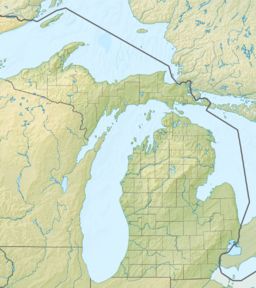
The Thousand Islands – Frontenac Arch region or the Frontenac Axis is an exposed strip of Precambrian rock in Canada and the United States that links the Canadian Shield from Algonquin Park with the Adirondack Mountain region in New York, an extension of the Laurentian mountains of Québec. The Algonquin to Adirondacks region, which includes the Frontenac Axis or Arch, is a critical linkage for biodiversity and resilience, and one with important conservation potential. The axis separates the St. Lawrence Lowlands and the Great Lakes Lowlands. It has many distinctive plant and animal species. It is one of four ecoregions of the Mixedwood Plains.

Belize is a country with a rich variety of wildlife, due to its unique position between North and South America, and a wide range of climates and habitats for plant and animal life. Belize's low human population, and approximately 8,867 square miles (22,970 km2) of undistributed land, provides an ideal home for more than 5000 species of plants, and vast numbers species of animals — with several hundred vertebrates including armadillos, snakes, and monkeys.

Marine reptiles are reptiles which have become secondarily adapted for an aquatic or semiaquatic life in a marine environment.
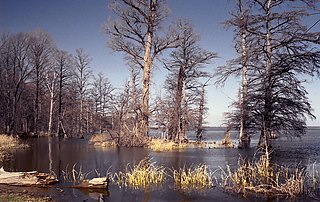
Reelfoot Lake State Park is a state park in the northwest corner of Tennessee in the United States. It encompasses Reelfoot Lake and is situated in Lake and Obion counties. The park itself makes up 280 acres (1.1 km2), divided into ten sections around the lake. A major hunting and fishing preserve, it is part of a much larger wildlife refuge which comprises 25,000 acres (100 km2), 15,000 acres (61 km2) of which are water, and harbors almost every kind of shorebird, as well as the golden and American bald eagles. Other animals are also diverse and abundant. The many species of flowering and non-flowering plants attract botany enthusiasts from all over the country. Baldcypress dominates the margins of the lake, but many other trees and shrubs are also present.

The round goby is a fish. Defined as a euryhaline bottom-dwelling goby of the family Gobiidae, it is native to Central Eurasia, including the Black Sea and the Caspian Sea. Round gobies have established large non-native populations in the Baltic Sea, several major Eurasian rivers, and the North American Great Lakes.

The brahminy river turtle or crowned river turtle is a species of turtle in the family Geoemydidae. The species is endemic to South Asia.
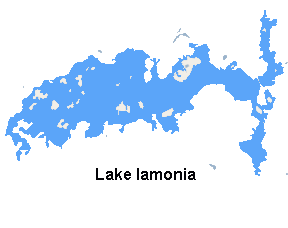
Lake Iamonia ⟨aɪ ˈmoʊ njə⟩ is a large, subtropical prairie lake in northern Leon County, Florida, United States, created during the Pleistocene epoch.

The fauna of Canada consist of approximately 200 mammal species, over 460 native bird species, 43 amphibian species, 43 reptile species, and 1,200 fish species. The biology survey of Canada cites that there are approximately 55,000 species of insects, and 11,000 species of mites and spiders.

The fauna of the United States of America is all the animals living in the Continental United States and its surrounding seas and islands, the Hawaiian Archipelago, Alaska in the Arctic, and several island-territories in the Pacific and in the Caribbean. The U.S. has many endemic species found nowhere else on Earth. With most of the North American continent, the U.S. lies in the Nearctic, Neotropic, and Oceanic faunistic realms, and shares a great deal of its flora and fauna with the rest of the American supercontinent.

The fauna of Nicaragua is characterized by a very high level of biodiversity. Much of Nicaragua's wildlife lives in protected areas. There are currently 78 protected areas in Nicaragua, covering more than 22,000 square kilometers (8,500 sq mi), or about 17% of its landmass.
Enzo Creek Nature Sanctuary, named after the creek that divides the sanctuary North to South, is a 150-acre (0.61 km2) privately managed wildlife sanctuary located in Mecosta County, Michigan near the city of Big Rapids. The objective of the sanctuary is to enhance the habitat of the sanctuary for the benefit of the fish and wildlife which live within or migrate through the sanctuary.

The wildlife of Cambodia is very diverse with at least 162 mammal species, 600 bird species, 176 reptile species, 900 freshwater fish species, 670 invertebrate species, and more than 3000 plant species. A single protected area, Keo Seima Wildlife Sanctuary, is known to support more than 950 total species, including 75 species that are listed as globally threatened on the IUCN Red List. An unknown amount of species remains to be described by science, especially the insect group of butterflies and moths, collectively known as lepidopterans.

The Pere Marquette River is a river in Michigan in the United States. The main stream of this river is 63.9 miles (102.8 km) long, running from Lake County south of Baldwin into the Pere Marquette Lake, and from there into Lake Michigan.

All of the animals living in Asia and its surrounding seas and islands are considered the fauna of Asia. Since there is no natural biogeographic boundary in the west between Europe and Asia. The term "fauna of Asia" is somewhat elusive. Temperate Asia is the eastern part of the Palearctic realm, and its south-eastern part belongs to the Indomalayan realm. Asia shows a notable diversity of habitats, with significant variations in rainfall, altitude, topography, temperature and geological history, which is reflected in its richness and diversity of animal life.
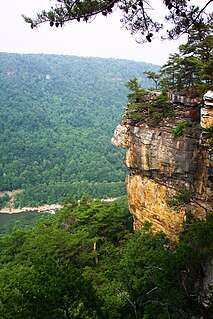
The life zones of West Virginia allow for a diversity of habitats for fauna, varying from large lowland farming valleys bordered with forest and meadow to highland ridge flats and heavy forestland, some with rocky ridge-line peaks. The "Mountain State" harbors at least 56 species and subspecies of mammals. The state has more than 300 types of birds and more than 100 species of fish.

The fauna of Bangladesh includes about 1,600 species of vertebrate fauna and about 1,000 species of invertebrate fauna based on incomplete records. The vertebrate fauna consists of roughly 22 species of amphibians, 708 species of fish, 126 -species of reptiles, 628 species of birds and 113 species of mammals. The invertebrate fauna includes about 30 species of aphids, 20 species of bees, 178 species of beetles, 135 species of flies, 400 species of spiders, 150 species of lepidopterans 52 species of decapods, 30 species of copepods, 2 species of starfish and some species of sand dollars, sea cucumbers and sea urchins. Bangladesh's wide variety of ecological conditions, encompassing the long sea coast, numerous rivers and their tributaries, lakes, haors, baors, ponds and other forms of wetlands, lowland evergreen forests of tropical nature, semi-evergreen forest, hill forests, moist deciduous forests, swamps, and flat lands with tall grasses, has ensured the vast diversity of species found in the country. However, the increasing population, unplanned urbanization and expansion of agriculture and industry have been significantly affecting the ecological structure of Bangladesh, leaving several species extinct and many others endangered.

The fauna of Louisiana is characterized by the region's low swamplands, bayous, creeks, woodlands, coastal marshlands and beaches, and barrier islands covering an estimated 20,000 square miles, corresponding to 40 percent of Louisiana's total land area. Southern Louisiana contains up to fifty percent of the wetlands found in the Continental United States, and are made up of countless bayous and creeks.
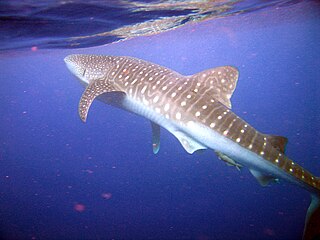
The flora and fauna of Honduras reflects the country's geographical location inside the tropics. This has allowed for diverse species of plants and animals to be adapted, but some of them are now in danger of extinction. This has posed the Honduran government, offices and nature organizations to look after the protection of the local environment, like the creation of nature reserves.

